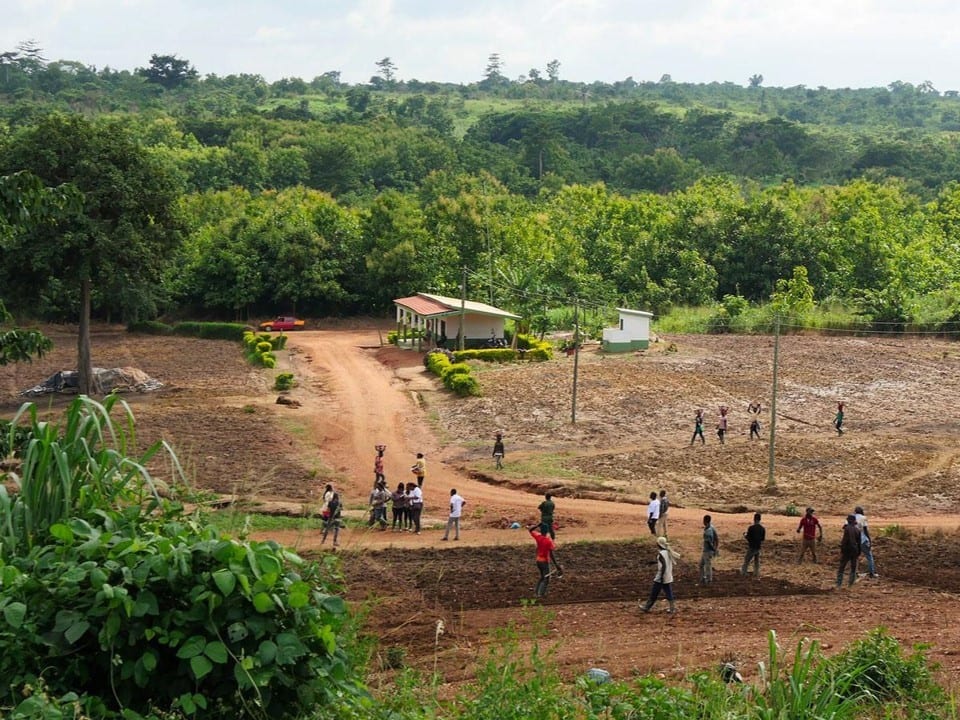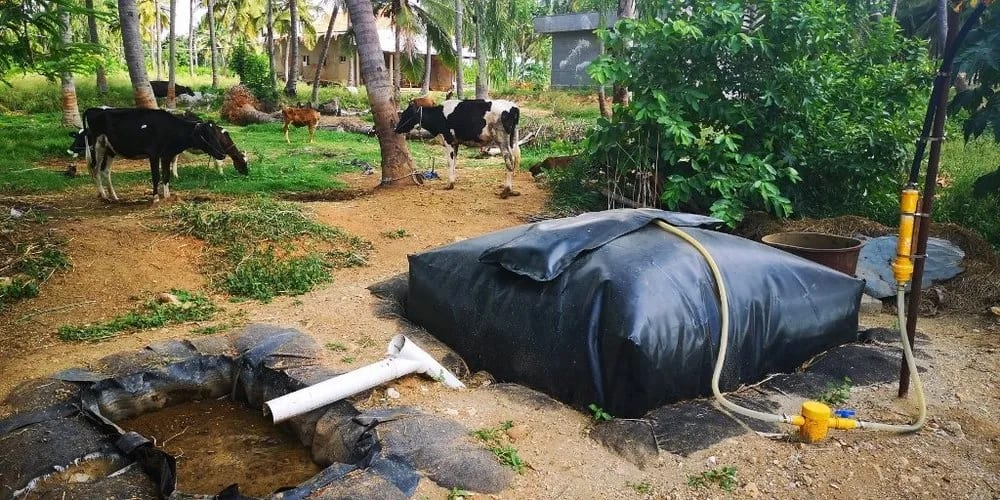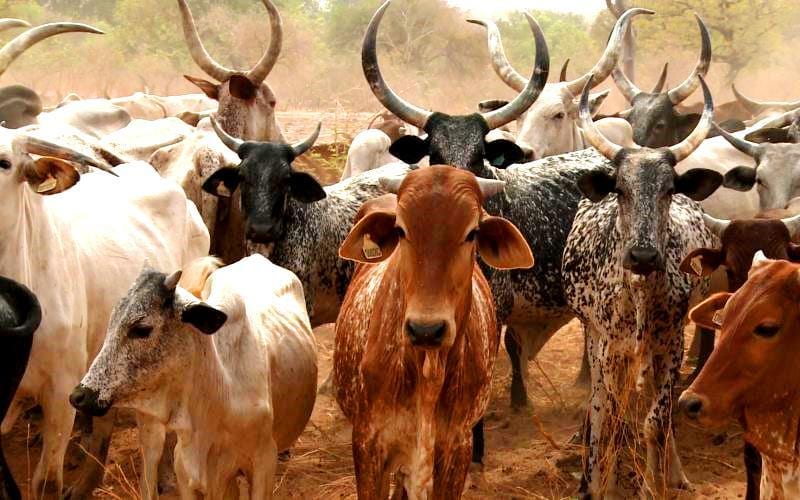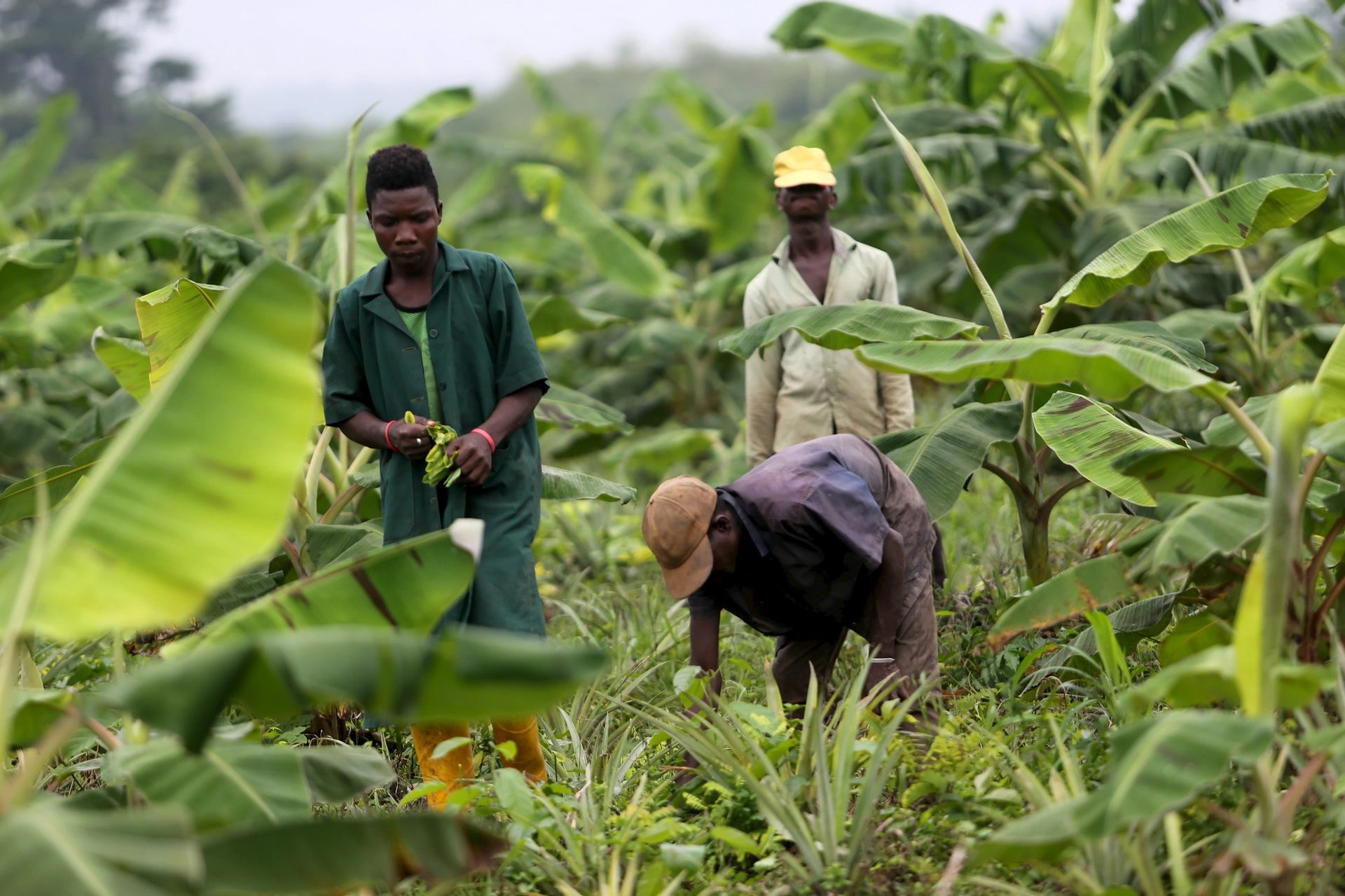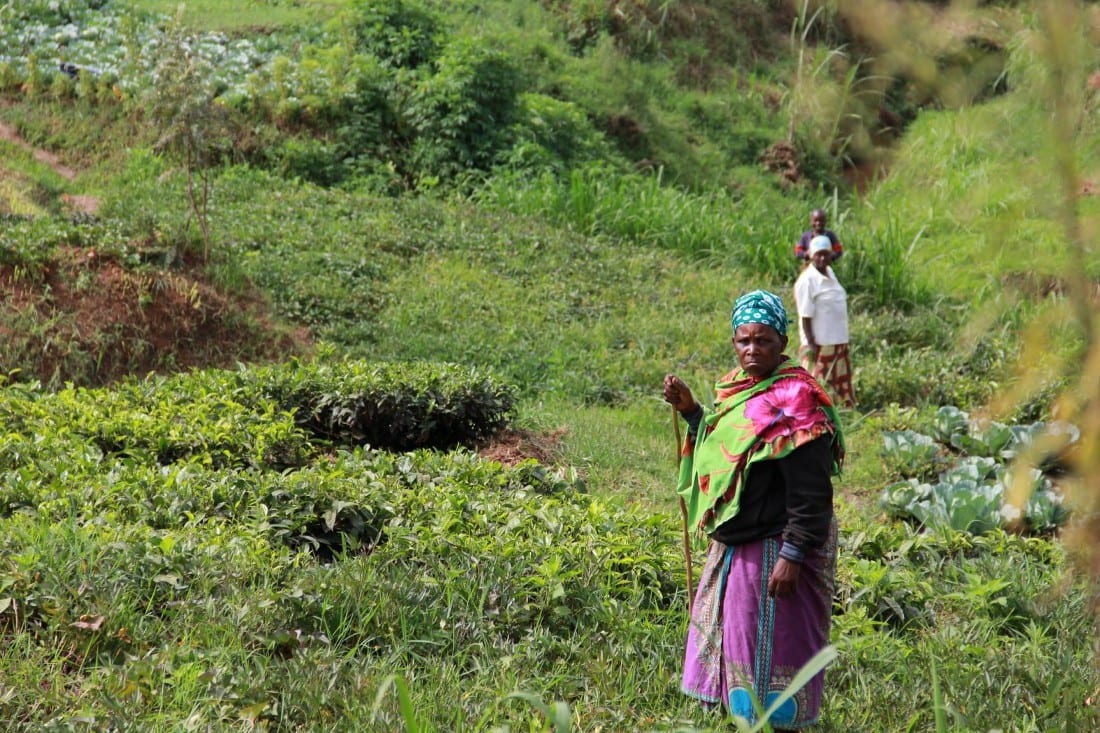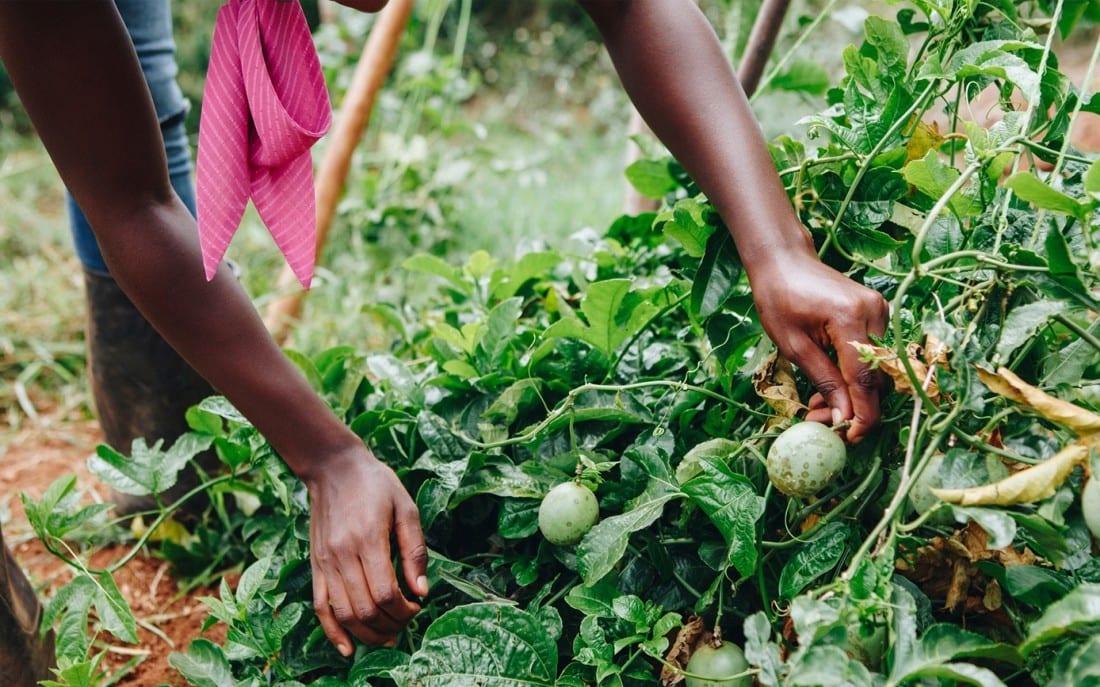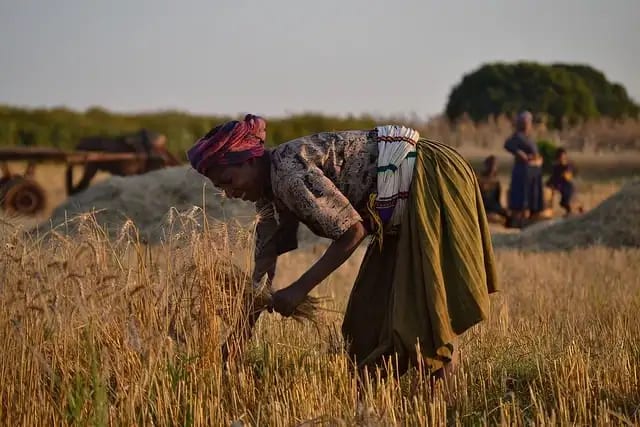Which is why 75% of South African farmers choose to grow without fertilizer.
Fertilizer is three times more expensive in South Africa than the rest of the world
Low fertilizer rates in South Africa leads to crop yields 80% below the global average
Putting millions at risk of starvation, malnutrition and poverty
The Why and How of Anaerobic Digestion in Africa
By Rachel Lee
Africa has the lowest agricultural productivity in the world. It is the only country that per capita food production has decreased over the last 30 years. Across practically all countries except Africa, crop yields have skyrocketed since the green revolution. 1 So this begs the question, why is agricultural productivity in Africa so low?
It isn't a land or space problem. Africa is home to 60% of the world's arable land 2, which means there is tremendous potential for Africa to not only produce enough food to sustain itself, but also become a global exportor of food. In fact, Africa has the potential to produce 3 times more cereal grains each year, the equivelant of 2.6 millions tons of food. 3
So the obvious thought is why does Africa's full agricultural potential remain untapped. Why are yields still so low?
The culprit is resources. Specifically fertilizers.
Fertilizer in Africa is 3 times more expensive than the rest of the world, making fertilizer unafforable for the majority of South African farmers. (Many reasons for the outrageous fertilizer costs in South Africa. The largest cause is that Africa imports over 80% of it's fertilizer from Europe, and the transportation, inflation, and tarriff fees contribut to the costs. Read more about the reasons behind the high cost of fertilizer here!) Because of this, 75% of farmers in South Africa make the choice to do without fertilizer, because the benefits of using it are not worth the finanical cost. 4
The expensive costs of fertilizer is just one aspect of the problem. The other aspect of fertilizer is the environmental impact which can affect yields and costs in the future. Starting right from production via the Haber Bosch process, fertilizer production accounts for 1.8% of all greenhouse gas emissions, releasing 6 tons of CO2 into the atmosphere for every ton of ammonia produced. 5 6
Once synthetic fertilizer is produced and shipped all over the world to farms (more pollution), the fertilizer is applied to fields which creates a long list of soil problems. The largest is that only 50% of the fertilizer applied to fields actually makes it to the crops it was intended for. 7 The half that does reach the plants leaches into soils reducing pH, depleting nutrient in the soil, leading to errosion and killing important soil microbes. The other half applied washes away as runoff, ending up in bodies of water. The high nitrogen and phosphorus content of fertilizer causes eutrophication of water, which is large algal blooms called dead zones which kill all marine life in the water. The largest dead zone is 63 700 square feet off the Gulf of Mexico. 8

Dead zone off the Gulf of Mexico which spans 6334 miles. photo credit
To solve the fertilizer issue in South Africa we must give African farmers the tools they need to become completely self sufficient. This starts with placing the technology of fertilizer production in the hands of the farmers. South African farmers need autonomy.
What if small scale farmers could produce fertilizer in their own backyard out of the agriculture waste, food waste, and human excrement they already produce?
This is what the technology of anaerobic digestion enables. It provides the opportunity to decentralize fertilizer production and transform massive fertilizer plants into tiny digestors in farmer's backyards.

Pull the arrow to see the decentralization of fertilizer production
Anaerobic Digestion is positioned as a perfect solution to the fertilizer problem in South Africa. It provides a way for farmers to create their own fertilizer with the waste they produce, and create a renewable fuel at the same time. It's a win-win!
Anaerobic digestion (AD) is a process where bacteria break down organic matter like agricultural waste, manure and food waste into biogas. Biogas is a renewable energy source made of 60% methane, 39% carbon dioxide, 1% hydrogen sulfide that can be used for electricity, cooking, and heating. 9 A by product of the AD process is digestate, a nutrient rich sludge which can be used as fertilizer. Finding a way to improve the nutrient concentration of digestate to the same concentration as synthetic fertilizers could allow synthetic fertilizer to be completely replaced with digestate fertilizer.
The AD process checks all the boxes. It is very environmentally friendly, it is cheap (depending on the model used), can be done in a small amount of space and produces two incredibly useful products: biogas and digestate, all by using bacteria to turn trash into treasure!
Turning trash into treasure: anaerobic digestion
Anaerobic digestion is like a living system with bacteria that must be looked after. The "home" for the bacteria must be kept at a certain pH and temperature (which we will talk about later), but most importantly, the digestor needs to be regularly fed. Just like all living things need food, so does AD.
The food (aka waste) that goes into the digestor is called feedstock. Feedstock is fed into the digestor everyday to keep the digestor healthy and the bacteria operating smoothly (and so that a constant supply of biogas and digestate is created). There are three different catagories of feedstock for AD:
- Municipal waste - Human excreta, organic municipal solid waste, food waste, cooking oil
- Agricultural waste - Manure, algal biomass, agro-industrial waste, crop trimmings/stocks, rotting food
- Industry waste - Slaughterhouse waste, food processing waste, biochemical waste, pulp and paper waste, brewers grain
Feedstocks are very hearty, and can basically digest any organic waste. The only feedstock anaerobic digestors can't take is materials high in fiber or cellulose, things like wood or bark, or any inorganic waste like textiles, glass or metals. 10
Food is fuel 😋
The organic biodegradable fraction (VS) is the percent of the total mass that is used to make biogas and digestate, which is the organic simple compounds. The amount of organic simple compounds in digestate determine what the VS is. The higher the amount of organic simple compounds, the higher the VS and vice-versa.
The VS of the feedstock determines the amount of biogas and digestate that will be produced. To optimize for high biogas and digestate yields, a feedstock with a high VS should be chosen. (Lower VS feedstocks are still perfectly fine, just don't produce as much biogas or digestate.
The 'best' VS percent is between 70-95% of the total mass. A feedstock with less than 60% is not used in AD because it is too inefficient. 11
Organic biodegradable fraction
% of biodegradable fraction of total mass
Type of organic waste
VS % of Different Feedstocks
Agricultural waste has the highest VS percentage, making it the best feedstock. This is a massive opportunity for South African farmers to anaerobically digest their on-farm agriculture waste & household waste to turn it into biogas and fertilizer.
There is one checkbox that must be checked before an AD system can be installed: Is there a steady source of feedstock? If the answer is yes, then AD is an amazing option to turn waste into two very useful products. If the answer is no, things become more complicated...
The anwser to this question in Sub Saharan Africa is YES. The very exciting thing is that Sub Saharan Africa is the perfect market to expand anaerobic digestion to: 57% of the total waste generated in South Africa is organics, the feedstock needed for AD. 12
Feedstock source in South Africa

Most of this waste is dumped in landfills, incinerated, or dumped in waste streams, which is very toxic for ecosystems. After sitting in landfills/bodies of water, the waste starts releasing CO2 and methane (a greenhouse gas 300 times more potent than CO2) emissions. 13 If rotting organic waste was a country, it would be the 9th leading emitter of greenhouse gases. 14 The environmental impact of waste is completely underrated. And on top of this, as waste in landfills decomposes, toxic chemicals and heavy metals leach into the soil raising soil pH and damaging soil health, AND draining into and contaminating groundwater.
As if this wasn't already enough, the waste dumped in bodies of water not only causes severe damage to ecosystems, but also contaminants the communitie's water source, leading to diarrheal diseases, the leading cause of death for children under the age of five.
It is criminal that this much organic waste is thrown away. It is like chucking millions of tons of renewable energy and fertilizer out the window. Organic waste is a very important resource that is usually overlooked because it smells bad and is inconvienant. But the win that organic waste has over other renewables is that it doesn't cost anything. Africa produces 170 000kg of organic waste a year, and most of this is thrown out. 15 Harnessing the power of organic waste in South Africa is like the 'third door' that hasn't been thought of. It is cheap and there is a lot of it.
Classification of waste generated in Sub Saharan Africa
Hover over the graph to see the percents of each kind of waste!
Now, time to dive into the nitty gritty, the steps of anaerobic digestion.
But before the AD process can start pre treament is needed. Pre treating the feedstock speeds up the AD process and increases the biogas and digestate yields.
Think of pre treatment like making banana muffins. The smart thing to do is to take the frozen bananas out of the freezer and thaw them out a few hours before your baking fiasco. It will be easier to make the muffins (you will save your arm a lot of pain from mashing those frozen bananas), no big clumps of frozen banana will be in the batter and they will probably cook better. BUT if you don't thaw the bananas out, it is not the end of the world. You will just end up with a sore arm and clumpy muffins.
Pre treatment works the same in the sense that it is not mandatory, pre treatment can be skipped, but there are a lot of negative effects if it is.
There are three steps in pre treatment:
Sorting
Most households in South Africa don't sort their waste. Their trash cans are made up of organic waste plus all other kinds of waste like metals, plastics and textiles. The first step in pre treatment is to sort the waste and separate the organics.
For househol digestors, sorting is manually done, whereas in commercial digesting plants, this is done mechanically. It is essential that the waste is sorted extremely well before it goes into the digestor. This will ensure the highest quality and yield of digestate and biogas. (Fibrous materials like straw and wood must be removed from the waste since fiber cannot be anaerboically digested.)
The easiest way to sort the waste is called source segregation, which is manually sorting the waste at the source - this looks like having a special bin for organic waste.
Reducing size
Once the waste is sorted into organics, it must be broken down into physically smaller parts. All waste going into the digestor should be 5cm in diameter or less. This will speed up the digestion process and allow the bacteria to easily digest the waste.
Shredding is the best way to reduce size, because it decreases particle size and increases surface area at the same time. This allows the microorganisms to degrade the waste quicker.
Manual mincing machines are another option to reduce size, but can be expensive to buy and maintain. They also require energy to run.
The easiest way to reduce size, and the most common option in developing countries, is manually at the source. As households sort their organic waste, they manually cut the waste into smaller pieces.
Adding water
The final step in pre treatment is adding water to the dry feedstock. The volume of feedstock fed into the digestor is the volume of digestate you will get out. Adding water increases the yield and introduces beneficial bacteria to the liquid.
The amount of water added to the feedstock depends on the kind of digestor being used (something we explore in the next section!)
If too much water is added to the digestor, the nutrient concentration decreases, the digestate becomes diluted and yields decrease. Too little water means the sludge is too thick, which clogs the pipes and increases the heat needed to run the dgestor. 16
Pre treatment = making 🍌🧁
The outcome
"What you put in is what you get out"
This is like the definition of anaerobic digestion. The amount of feedstock that is fed into the digestor each day is the amount of digestate and biogas that will come out. If 10kg of feedstock are fed into the digestor each day, roughly the same weight in digestate will be produced.
Biogas is a bit different. 10kg of biowaste is needed to produce one cubic meter of biogas. This amount of biogas contains 6 kWh (or 21.6 MJ) of energy, which is equivelant to 0.92L of total gas. 17
The digestate left behind is a liquid slurry which will need to be processed more before it can be used. Digestate contains 30% more nitrogen compared to the raw organic waste that was fed into the digestor. 18 (Yet another testament to the stunning benefits of using digestate as a fertilizer.)
Creating the perfect home 🛖
The conditions inside the digestor must be perfect. If not, the bacteria will either slow down (making the AD process much less efficient) or kill the bacteria, both things we do NOT want.
To maintain a healthy and optimal home inside the digestor, three things are monitored: temperature, pH, and mixing frequency.
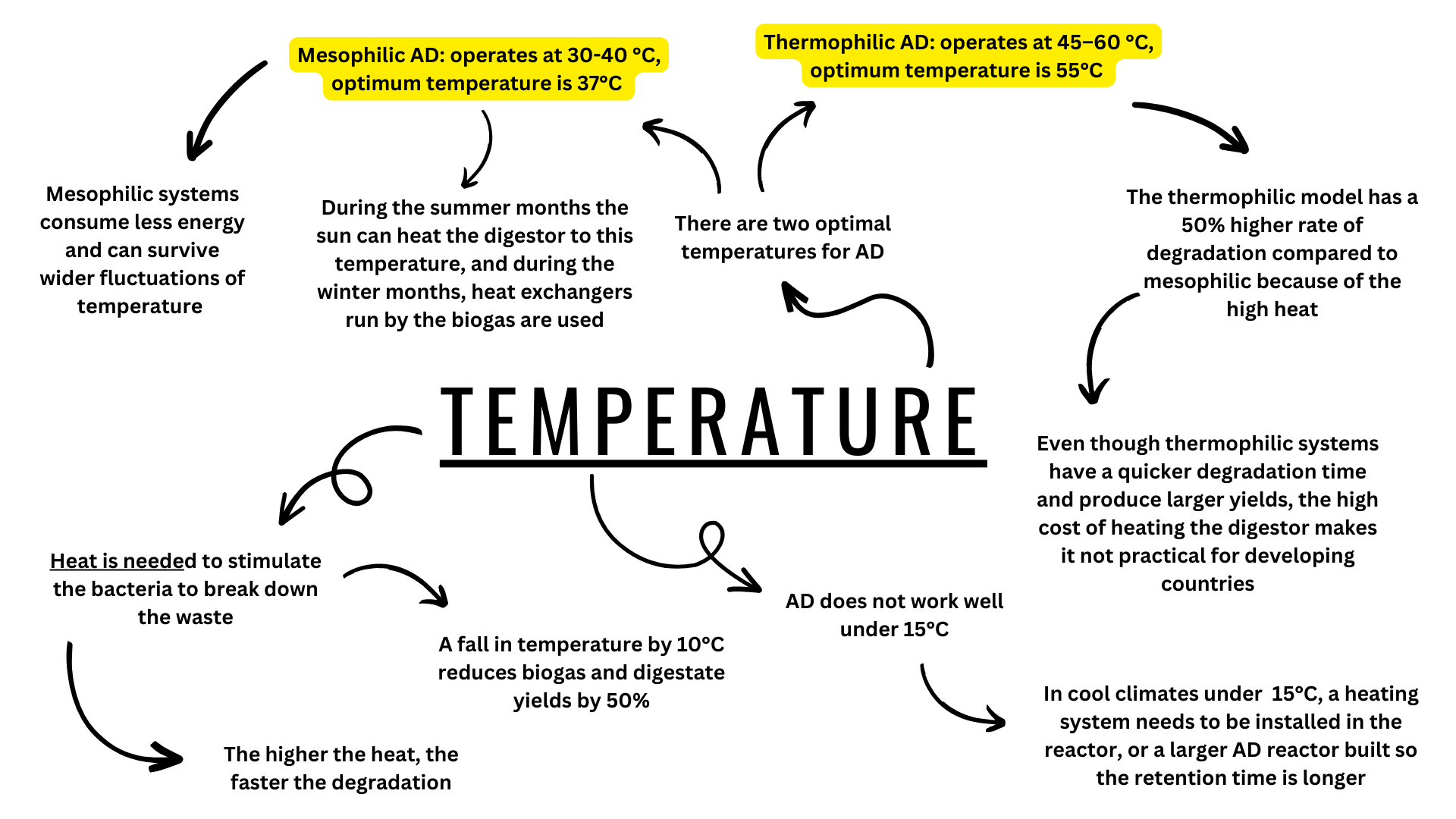

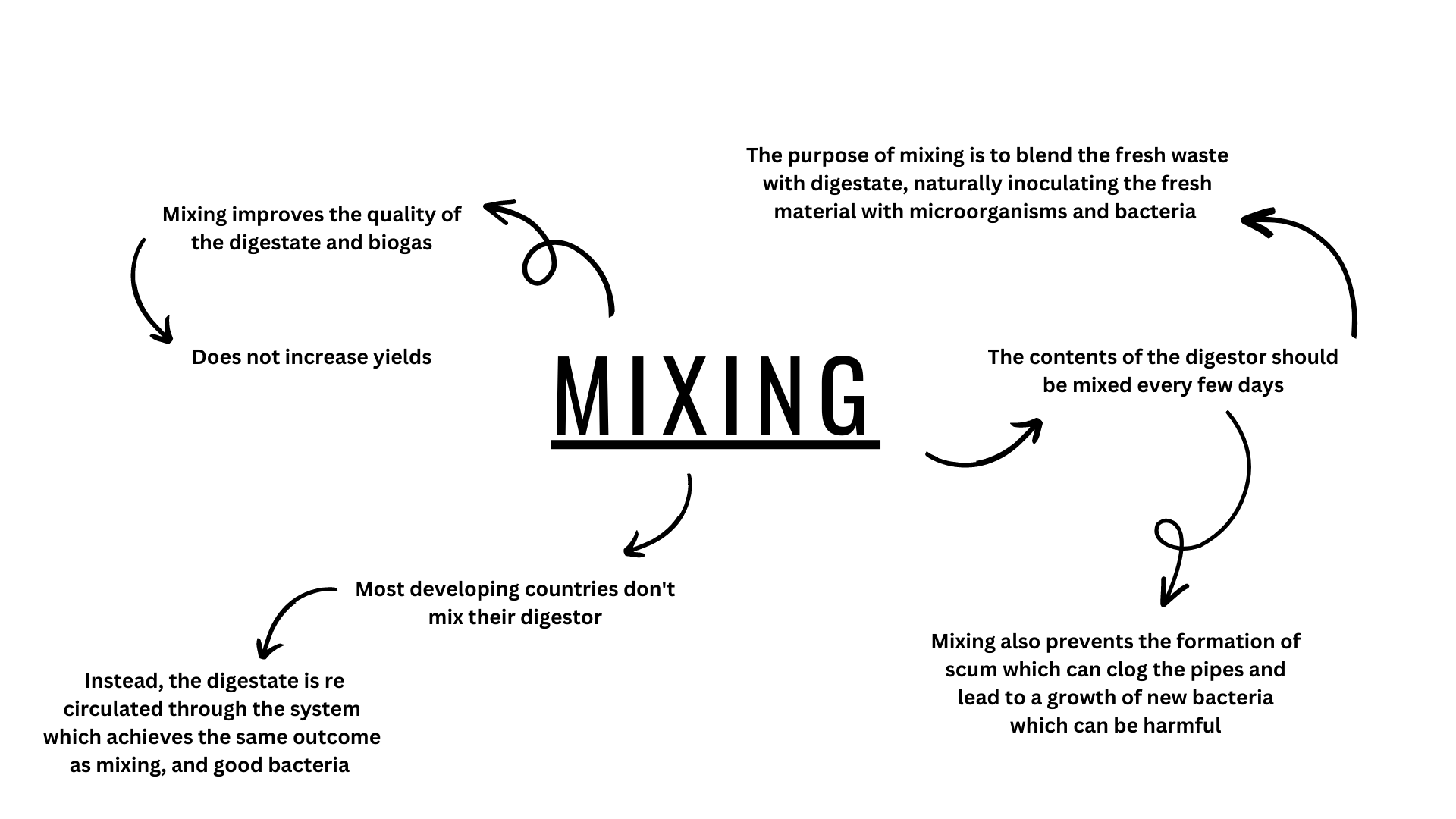
Different models of anaerobic digestors
Anaerobic digestion is not one singular process. There are dozens of different models of AD, each tailored for a certain area, kind of feedstock, price range and scale of system.
Wet vs dry
The mixture inside wet systems has a dry mass content of 16%, and the rest is water. (aka wet systems are primarily made of water.) Dry systems are the opposite. The mixture has a dry mass content of 22-40% (sometimes up to 60%) and the rest is water.
Dry systems are more efficient because they need less volume (take up less space), which means they need less energy to operate. The digestate produced from dry systems is easy to separate and use as fertilizer, whereas the digestate from wet systems is much more liquid which can be harder to process into fertilizer.
Continuous vs batch fed
Digestors can be fed a little bit every day (continuously) or filled to the top every few months (batch wise.)
In a continuous feeding model, the digestor is fed every day, and at the same time, an equal volume of biogas and digestate leaves the digester. Most biogas plants in developing countries operate in continuous mode.
In batch fed digestors, the digestors are filled to the top with feedstock, closed for a few months while the bacteria digests the feedstock, and opened up again months later. The downside of batch fed is that biogas and digestate are not produced everyday, they are only produced once every few months. This is fine for large scale digestors where the biogas and digestate can be sold in large amounts when they are harvested, but this is super impractical for small scale digestors in developing countries where the household relies on biogas daily as their cooking fuel.
Single stage vs multi stage
The single stage model is typically used for small scale, household size digesotrs, and the multi stage model is typicallyused for large scale plants with a capacity of 50 000 tons/year.
Single stage digestion is one digestor which all the steps happen in.
Multi stage digestion is made up of multiple reactors, one for each of the four steps in AD. Each individual reactor is kept at the pH, temperature and bacterial activity level that is optimal for each step, which maximizes efficiency and yield. Multi stage systems are incredibly effective and produce almost double the yields of single stage digestion. Even though multi stage has so many benefits over single stage, it isn't practical for developing countries because it has much high operation costs, takes a lot of energy and maintenance to run, and is more complicated than a single tank. 19
The beauty of anaerobic digestion is the simplicity. All it needs is a big container, some cow poop for the bacteria and some organic waste. Yes, the process can get much more complicated than that in large scale commercial AD plants, but small scale systems reley on the simple and effective process of bacteria breaking down waste which has existed for billions of years.

Flip through the images to see different AD systems in developing countries
These three models of AD can be applied to the different kinds of anaerobic digestors. Wet vs dry, continuous vs batch fed and single stage vs multi stage is like the icing on the banana muffins - the flavour of icing is crucial to the taste of the cupcake, but not the most important part. It's that banana muffin that we need to get right. The banana muffin in this case are the four most common kinds of anaerobic digestors used in developing countries: fixed dome, floating drum, tubular and garage-type.
Kinds of anaerobic digestors
The fixed dome digester is the simplest and most common of all digesters. 75% of the total volume is for the slurry, and 25% is for gas storage. Fixed dome digesters are usually built underground, to protect the microorganisms from the cooler temperatures. 20
It is made of a cement or stone dome that does not move, the inside of the dome is the digester where the digestate and biogas is produced. There are three main pipes: an inlet pipe where the feedstock is fed into, an outlet pipe where the liquid digestate comes out, and an outlet pipe where the biogas comes out.
The digestate is produced at the bottom part of the digester, and the gas is produced at the top part. As biogas is produced, the pressure inside the digester rises, pushing the digestate out into the digestate storing tank. When the gas pipe is opened and the biogas is used, the pressure inside the digester lowers and the digestate flows back into the digester.
Fixed dome digester
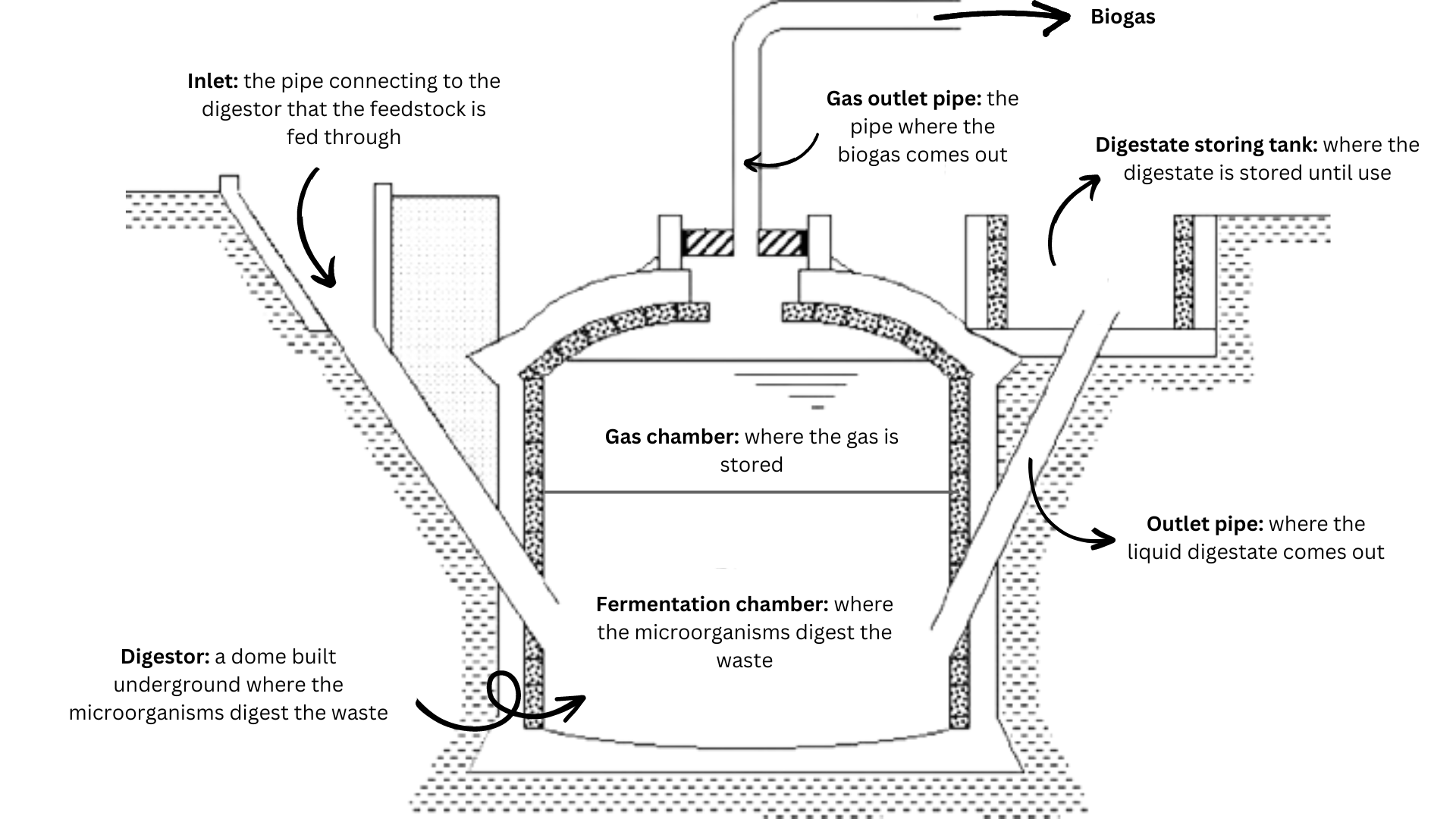
The size of fixed dome digesters can be anywhere from super small, to super big, ranging from 6m3 for a household digester, to over 50m3 for a commercial digester. Fixed dome digesters are usually used for manure and human waste, but can really be used for all waste - kitchen waste, grey water, agriculture waste and food waste.
Let's go through the advantages and disadvantages of the fixed dome digester:
Advantages
- Low construction cost
- Long lifespan (20-50 years)
- Has no moving parts which decreases the maintenance required
- Fairly easy to build
- If the dome is built underground, it saves space AND protects the digestor from temperature fluctuations
- It is very easy to feed the digester and collect the digestate and biogas
Disadvantages
- It is very hard to build fixed dome digesters on bedrock (fixed dome works best in clay and softer ground)
- It is hard to repair the digester once it's built since it is underground
- Gas leaks can happen if the pipes are loose or if there's a crack in the dome (which is hard to fix)
- It is hard to see if the digester is damaged since it is underground
- If the dome and pipes aren't completely air tight, biogas will escape (inefficient) and oxygen will get into the digester (bad) which kills the bacteria 21
The floating drum digester has two parts: the digestor, and the drum holder.
The digester is usually built below ground like fixed dome digesters, and the drum holder is above ground. (Usually small scale, household digesters have the entire system above ground).
The digester is a cylinder made of bricks, concrete or stone where the microorganisms digest the waste. Just like the floating drum digestor, there are three pipes: the inlet pipe where the feedstock is fed, the outlet pipe where the digestate comes out, and the gas outlet pipe where the biogas comes out.
As the bacteria digest the waste and biogas is produced, a small pump at the bottom of the digester pushes the gas upwards and into the gas tank, or 'the drum.' The drum rises upwards as it is filled with gas, and falls back down when the gas is lower. This floating drum is especially useful for households using the biogas fro cooking, heating or electricity, because the height of the drum acts as a visual indicator of how much biogas there is. So as a person is cooking inside on a biogas stove, they can look out the window and see how much time they have left before the biogas runs out.
Floating drum digester
The pressure inside the digestor depends on the weight of the drum. The heavier the drum, the higher the pressure, the lighter the drum, the lower the pressure. To increase the pressure of the digestor, rocks and weights can be added to the top of the digestor.
Usually the drum is directly above the digestor, but it can also be in a specifically designed drum a few feet away with connecting pipes.
The drum is made of steel and coated with a special anti-corrosion paint to protect the drum from errosion - this means that regular de-rusting and painting is required.
Let's go through the advantages and disadvantages of the fixed dome digester:
Advantages
- Very simple system
- The amount of gas produced is visible and easy to see
- Constant gas pressure can be easily made by adding weights to the drum
- Fairly easy to build
- Construction errors do not cause any major problems of inefficiencies
Disadvantages
- The cost of the steel for the steel drum is very expensive
- The drum easily corrodes
- Has a short lifespand (3-5 years in a hot and humid area, or 8-12 years in a more temperate climate)
- Regular maintenance costs for painting the drum add up $$$
- It's hard to mix the digester since the biogas drum is directly above the digester. Because of this, a layer of scum forms on top of the digester which can slow down the bacterial activity of the digester
- Maintenance and repairs of the digester is hard because it's underground 22
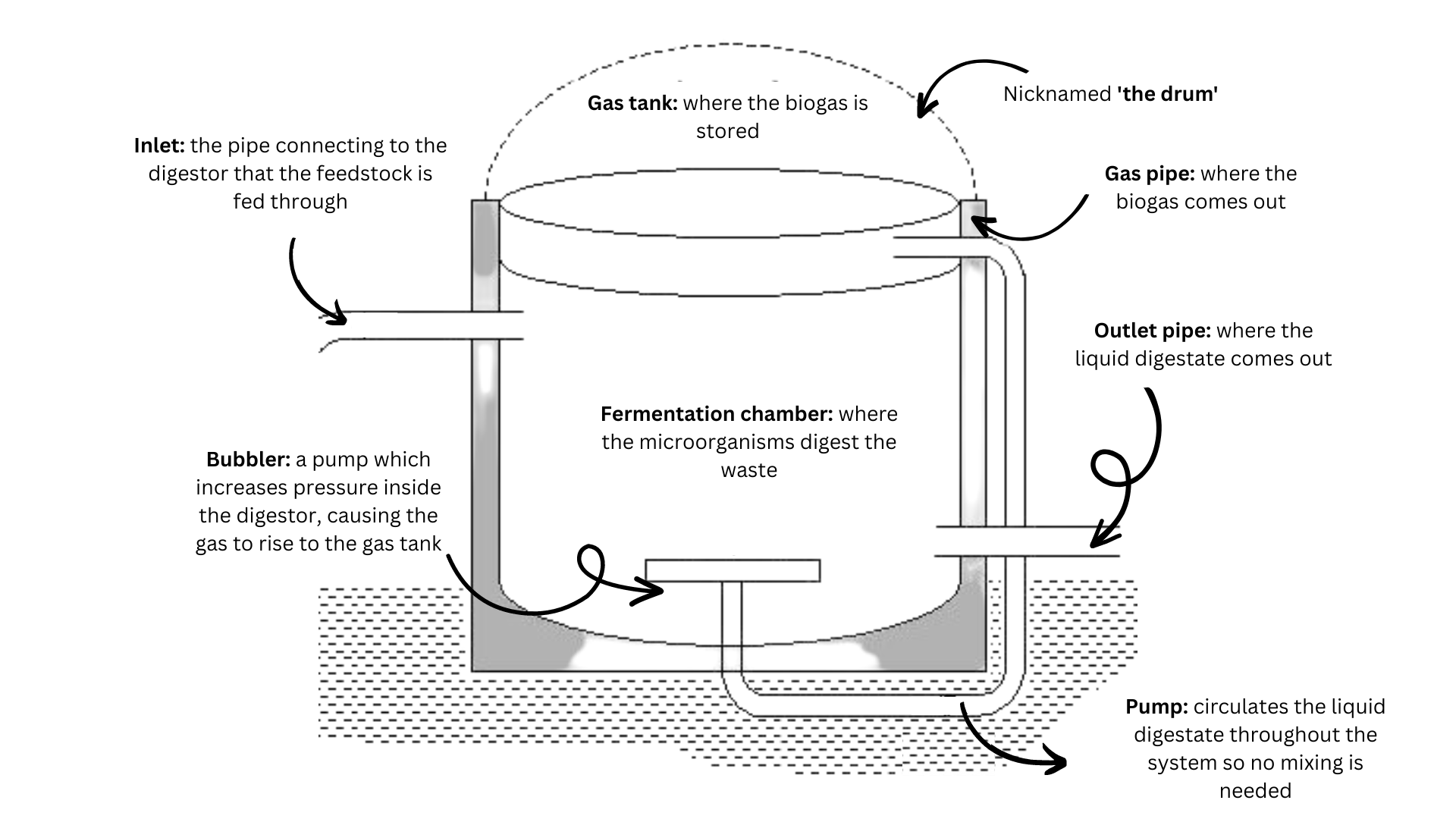
The tubular digestor is the least expensive of all the different kinds of digestors, because the material cost is so low. A tubular digestor is made of a long, weather resistant plastic or rubber bag which holds both the digestate and biogas. The gas is naturally stored at the top 25% of the bag, and the digestate naturally sinks to the bottom 75%. 23
The inlet and outlet are attached to the surface of the bag on opposite ends, and the gas pipe is at the top of the bag. Tubular digestors cannot be built underground, they must be above ground.
Tubular digester
Even though the list of advantages for tubular digesters is small, the tubular digester is the most promising kind of digester for developing countries because it is so simple, cheap and efficient. Don't get fooled by the number of pros and cons!
Advantages
- SIMPLE and customizable
- Very low construction cost
- Easy to build and maintain
- Tubular digesters can be built anywhere - on any kind of soil type, rock altitude, etc.
Disadvantages
- Has a short lifespan (2-5 years)
- The bag is very fragile and can easily rip, tear or break. Once the bag is broken, the digester can't be repaired so it must be replaced which is $$$
- Mixing is almost impossible since there is no opening at the top
- Since there is no mixing in tubular digesters, a layer of scum forms at the top
- The digesting waste can give off a strong smell since the material of the digester is not overly thick and the entire system is above ground
- Rodents and pests are attracted to the digester because of the smell of decomposting waste and can rip the bag to get to the waste 24

The garage type digestor is much different than the other ones. It operates in batch mode and is a dry system (complete opposites from the other three). All the waste and water are put into a container and sealed tight. Once the door is closed, a percolation system starts. The percolation system is like a shower on the roof of the digestor that sprinkles water over the feedstock, and disperses the AD bacteria evenly around the system. The perocolate shower mixes the feedstock and bacteria together, preventing a layer of scum from forming. The percolation system takes care of the mixing so we don't have to worry about that.
Once the percolation starts, it trickles down through the feedstock and bacteria, draining out a whole at the bottom of the reactor into a water storage tank. The percolate is then recirculated with a pump throughout the system, so the digesting waste is constantly being sprayed with water.
Garage-type digester
The problem with this design is that you only get biogas and digestate once every few months when the bacteria is completely done digesting the waste. This isn't a very practical system for households who are using AD as a way to generate continuous biogas for cooking, heating or electricity.
If the garage type digester is used for small household systems, multiple digesters have to run side by side so there is enough biogas and digestate produced that can be used.
Advantages
- SIMPLE and very easy
- Very low maintenance
- Only a very small amount of water is needed
Disadvantages
- There isn't a daily supply of biogas and digestate
- Multiple digesters need to run at the same time to make the same amount of biogas and digestate
- Biogas yields are lower
- The degradation time is longer than most other kinds of digesters
- Uses more energy to run the percolation system 25
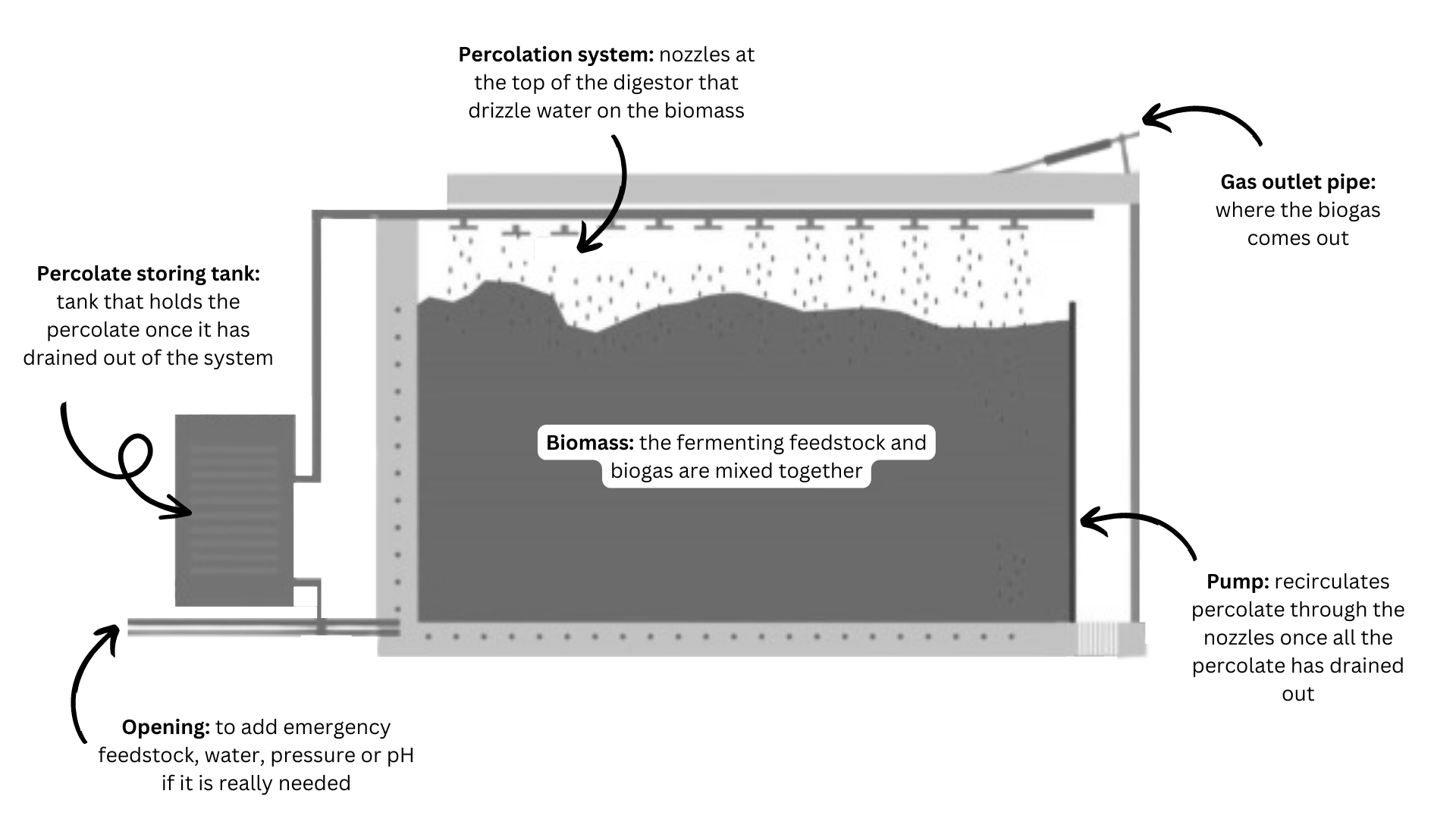
The star of the anaerobic digestion process is the AD bacteria. Without the anaerobic digestion bacteria, AD is just a big pile of rotting waste.
The great thing about bacteria is that they multiply quickly - the bacteria used in AD double every 14 minutes. 21 Because of the fast multiplying time, when the digester is just starting up, it needs a bit of starting bacteria to get it going, and then the bacteria will keep growing from there.
Growing this starting, or original, bacteria is called inoculation. Inoculation means introducing a pathogen or bacteria into something. In the case of AD, inoculation means introducing bacteria into the digestor that will kickstart the AD process. The bacteria used in AD inoculation is cow dung because it contains a high amount of NKP. (Really any form of manure other than human poop can be used. Human poop contains a high amount of toxic pathogens which can be harmful during the beginning of AD, but other animal manure has high bacterial activity which is very helpful during AD).
The cow dung is mixed with a 1:1 ratio of water and filled to at least 10% the total volume of the digestor. 26 (Sometimes up to 50% of the total volume is filled - typically, the more cow dung, the better!)
If the digestor isn't inoculated before the AD process, the feedstock will not be digested and the bacteria will die. Inoculation is crucial to the efficiency of the AD system. The original bacteria from inoculation is what we refer to as the 'AD bacteria'.
The star of the show...💩
Anaerobic digestion is a delicate process. Yes it is hearty (by hearty I mean that it can work well under many different conditions and takes different feedstocks), but it is much more complicated and sensitive than compositing. If the pH or temperature of mixing isn't optimized, the entire system will suffer.
To keep the AD system running smoothly and operating efficiently, there are many different routines and checks that need to be done. I've separated the maintenance of an anaerobic digester into the daily tasks, weekly-monthly tasks and anual tasks.
Daily
Feeding the digestor: the digestor must be fed everyday to give the bacteria food and to make sure there is constant biogas and digestate production.
Pre treating the feedstock: since feedstock is sonstantly being added to the digestor, the feedstock must be constantly pre treated (sorted, reduced to 5cm, added with water).
Weekly-monthly
Cleaning: if the biogas is used as cooking fuel, the stove must be cleaned bi-weekly
Check pH: the pH of the biomass in the digestor must be kept at 5.5-6.5. If the pH is below 5.5, the feeding needs to be stopped and started again once the pH re settles.
Check for leaks: the gas pipes, valves and fittings of the biogas and digestate pipes must be checked for leaks.
Annually
Pressure test: check the gas tightness of all the pipes and connectors.
Blockage test: check for blockages of feedstock or digestate in the inlet and outlet pipe. If there is a blockage, it must be emptied out.
Check digestate level: the digestate level in the digestate tank should be high in the morning and lower during the day as the gas is used. The digestate tank should be checked for leaks, runoff and any other issues.
Repainting: if the floating drum digestor model is used, the inside of the drum must be repainted every year to prevent rust and corrosion.
Remove sludge: a buildup of sludge will start to form on the bottom of the digestor because of the feedstock and digestate. This sludge buildup needs to be removed every 5-10 years. 27
Maintenance of an AD system
Now comes the exciting part. Once the process of AD is complete, the biogas can be used!
Biogas has a 55% efficiency, making it 3X more efficienct than solar energy, and 2X as efficient as hydro. 28 Biogas is perfectly positioned to be used as a renewable resource for everything from cooking to fuel.
Using biogas

Biogas Efficiency Compared to Other Renewables
Hover over the graph to see the percent efficiency of each renewable
The opportunity of using biogas in South Africa is really endless. There are SO many use cases of biogas and digestate to completely transform the source of fuel for households in South Africa and increase agricultural productivity.

Hover over each tab to see the uses of biogas and digestate in South Africa!
Cooking
Fertilizer
Lamps
Electricity
The most common uses of biogas in developing countries is stoves (for cooking), engines (for electricity or heat) and lamps (for light). The efficiency of each is shown below. 29
Biogas stove
Biogas lamp
Biogas electricity
Efficiency in %
Biogas stove



Direct burning of biogas in stoves is the best way to take advantage of biogas energy for households. Biogas as fuel has the potential to replace charcoal, wood and liquified petroleum gas.
H2S and CO2 are usually not removed from the biogas if it is used for a biogas stove.
300 liters of biogas are needed to cook for one hour with a double burner.

The biogas storage tank is hooked directly directly up to the stove by an inlet pipe. When the gas pipe is open, biogas will flood into the stove, through the mixing tube, and produce a flame. When the cooking is finished, the gas pipe can be turned off and the biogas will flood out from the pipe and into the storage unit.
Biogas electricity



Each cubic meter (m3) of biogas contains the equivalent of 6 kWh of heating energy.
When biogas is converted into electricity in a biogas powered electric generator, about 2kWh of useable electricity is made, and the rest is converted into heat which can be used for heating applications.
2 kwh is enough to power 20 light bulbs of 100 W each, or a 500 W generator for four hours.

To operate a 2 kW generator continuously, 24 m3 biogas is needed per day, which equals approximately 240 kg of biowaste per day.
Biogas lamp



Biogas lamps are not very efficient (3% efficiency), making them half as efficient as kerosene lamps. For this reason, biogas lamps are not used for efficiency, they are used for the low cost and abundent supply of biogas that is produced in a household system that makes biogas lamps cheaper than kerosene.
The biogas lamps used in developing countries consists of a fabric mantle which burns when it is used. This is not only a massive fire hazard, but it also makes the lamp very fragile and decreases the lifespan.
Biogas lamps only use 0.07 m3/h of biogas (very efficient), but the inefficiency is because most of the energy is lost as heat.
There has been A LOT of research about using biogas. Incredible applications of biogas in both developed and developing countries has been explored, which all have tremendous potential.
Digestate, on the other hand, has not received the same attention. Most AD plants and systems view digestate as a stinky, by product that is just an extra cost. Many AD systems dump digestate in bodies of water because digestate is not as good as synthetic fertilizer.
Now this is true. Digestate isn't as good as synthetic fertilizer. But this isn't a downside of digestate - this is actually a huge opportunity to process digestate to improve the nutrient concentration to make digestate as good as synthetic fertilizer.
Before we get to this though, let's run over some of the common uses of digestate:
Digestate can be used as fertilizer, compost, and irrigation water. All three uses are very simple and un-technical: the digestate produced each day is harvested and is treated to separate the water before use.(This can be done by filtering the digestate to separate the solids from the liquids, or running the digestate through a separation machine). The nutrient water can be used to irrigate crops or filter through a hydroponics system. The sludge can be used as compost or fertilizer, either applied directly to crops or processed into fertilizer pellets before application.
All of these options are great and provide benefits to the soil and plants, but not as much benefits as synthetic fertilizer. Digestate is usually used on farms as a soil additive to provide the soil with healthy bacteria and organic components...not as a material that can be processed into effective fertilizer. 30
Using digestate
Storing biogas and digestate
If biogas and digestate isn't used immediately it must be stored. Storing biogas is easy. You just feed the biogas outlet hose into biogas bags or storage units and store the biogas there until you need it. Biogas can be stored in airtight containers for very long amounts of time without loosing it's energy content (like all other renewables). This is a massive advantage of biogas over other renewables.
Storing biogas:
Storing digestate:
Storing digestate on the other hand, gets a little bit harder.
Digestate can be put in big bags, pits or storage containers just like biogas can, but digestate looses it's nutrient concentration over time from storage.
Digestate also takes up a lot of space. Biogas is a very compressed gas and volume wise doesn't take up much space, but digestate is the opposite. It has a large volume and takes up a lot space. Many small scale farms don't have this space to store digestate for months on end until it is fertilizer application time.
Which is the other thing - when storing biogas, it will only be stored for short periods of time. After a few days the biogas will be used and the amount in the storage tank will go down. With fertilizer, it is only applied to fields max two times a year. So the digestate that is accumulating every day has to be stored for months until it can be used. 31 32
Processing
The raw biogas and digestate that come out of the digester is not the biogas and digestate that will be used. Both products need to be processed to increase efficiency before they are used.
Processing biogas
Processing digestate

Flip through the different steps of biogas processing
It is crazy to think that a composting pile of poop and garbage could be the next renewable energy and a replacement to synthetic fertilizer.
It makes us wonder about the feasibility of AD. Do the economics line up? Is AD really worth it?
In my mind, the answer is a full-fledged YES.
Operational costs
The operational cost for an AD system depends on the size, location, and kind used. If there is local knowledge and professionals that know how to build and install AD systems, the cost will decrease.
The costs for large scale AD plants include electricity, water, transport of feedstock, spare parts and staff salaries. But the operational costs for a household digestor are practically nothing because all the labor is done by the household and the feedstock is generated on-site (weather that is agriculture waste, human waste or food waste)
Revenue
Revenue can be made by both digestate and biogas. Based on the energy source that can be replaced by biogas, if producing biogas is cheaper than other sources, biogas can generate revenue. If more biogas is generated than the household uses, biogas can also be sold, generating more revenue.
Digestate has massive potential to take care of the fertilizer needs of a farm and replace synthetic fertilizers. Properly storing and processing digestate should produce more fertilizer than the amount needed for the farm. This fertilizer can be sold to generate revenue.
Landfill cost
The most common waste management practice in South Africa is landfilling. Organics make up 70% of total waste in landfills. By digesting organics in AD plants, a large amount of total waste can be diverted from the landfill, saving space and extending the lifespan of the landfill. Money is also saved from the transport costs of waste to landfills, since households digest their waste on-site.
These are just the direct benefits of AD, the indirect benefits are less environmental pollution and improved living conditions and healthier soils which can lead to larger yields. 33
Is AD worth it?
Inputs needed for AD
It's not all sunshine and rainbows. Anaerobic digestion is not all good. There are a lot of drawbacks and negative effects of using AD that need to be taken into account, AND a lot of areas where much more research and innovation is needed.
Socio-cultural impacts
When designing a system for people, we must make sure we don't get caught up in the technical aspect, forgetting who the end user is. Long term, it is the socio-cultural aspects of anaerobic digestion that will determine if the system is successful.
For household anaerobic digestion, women must be included in every aspect of the design, planning and decision making right from the beginning. Women in developing countries are usually the most effected by new technology, especially if it's going to be used for cooking. Women are also the ones that need to feed the anaerobic digestor and fix it if there are malfunctions. It is crucial that women are a part of the decision making process and have access to resources to learn how to properly care and fix anaerobic digestors.
When switching to biogas, people's habits are changed. So when promoting AD, we must make people aware of the downside of AD as well:
- The amount of biogas produced each day is a fixed amount. Usually a 2nd cooking fuel will need to be used as backup
- Biogas cannot provide strong heat that is needed to cook some meals
- Meals cooked with biogas don��t taste the same as meals cooked with charcoal
- Charcoal embers keep the meal warm - this isn't possible with biogas 34
Its not all ☀️ and 🌈
Two big problems in South Africa can be addressed with anaerobic digestion: access to cheap and effective fertilizer, and the large amount of organic waste produced.
More money and research needs to be invested in the technology of anaerobic digestion and how to improve the nutrient concentration and effectiveness of digestate, so digestate can fully replace synthetic fertilizers. Innovation in the processing and refining of digestate and biogas is needed to truely unlock the full potential of anaerobic digestion, and equip South African farmers with the technology to become self sufficient.
And that's a wrap!

Hi I'm Rachel! I'm a 16 year old passionate about improving the food system in Sub Saharan Africa. Previously, I have worked on creating a strand of maize to feed more people in Lesotho by being pest resistant, nutrient dense and water resilient. I have worked on solar panels made out of bacteria, and a mobile shopping app for walmart. I am also the cohost of the TechnoGypsie Podcast, a podcast where my cohost and I explore how to leverage STEM to solve some of the biggest problems in the world. If I am not reading research papers or writing articles, you will find me running in the trails. I am an ultra runner obsessed with pushing my limits and finding out what I am capable of.
About the author
You may also like
